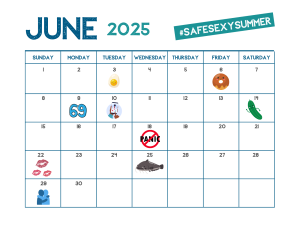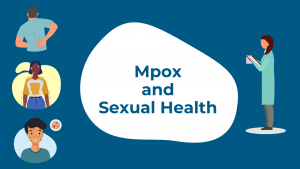
Celebrate the Start of #safesexysummer in June
It’s time to celebrate the start of summer! June is filled with national observances to help you start the summer off right. We’re here to help make June the start of a #safesexysummer.

The words sex and gender are sometimes used interchangeably, but they actually mean different things.
Sex—which is sometimes referred to as biological sex or your sex assigned at birth—is all about your body. It’s determined by a person’s chromosomes, their hormones, their (internal) reproductive organs, and their (external) genitals.
Usually when we talk about sex, we separate people into just two groups (male or female), though this is not entirely accurate (see below).
Gender is different because it’s also shaped by social and cultural norms and the expectation that males and females will behave differently. These expectations are sometimes called gender roles.
A person’s gender identity is their own personal perception of themselves as female, male, or some combination. A person’s gender expression refers to the ways they signal their gender identity to those around them. That includes things like clothes, hairstyles, and make-up as well their name and the pronouns they use.
Most people’s gender identity matches their sex assigned at birth, but for some people it does not. When a person’s gender identity and sex assigned at birth match, they may be called cisgender. When a person’s gender identity and sex assigned at birth do not match, they are often called transgender.
Gender exists on a spectrum. People may feel male or female or they may feel that neither of those terms explains their gender identity. These people are often referred to as non-binary. There are other terms like gender fluid or genderqueer that have similar meanings.
Some kids may have a sense of their gender identity at an early age while others may not start thinking about it until they are adolescents or even adults. A person’s gender identity may change over the course of their lifetime.
A person who was assigned male at birth but identifies as female may be called a transwoman. A person who was assigned female at birth but identifies as male may be called a transman.
Some transgender individuals use hormones to help their bodies better match their gender identity. A transman who takes testosterone, for example, will likely grow facial hair and develop a deeper voice.
Some transgender individuals have gender affirming surgery to change their bodies more permanently. The most common gender reassignment surgery is transmen who remove their breasts. Surgery to change genitals is far less common.
Some teens who are transgender—or think they may be—use puberty blockers to postpone the sexual changes that come with puberty. This gives them time to explore their gender identity and decide whether hormones are right for them.
Transgender individuals face a lot of stigma and discrimination in the United States and around the world. A survey of transgender adults in the U.S. found that 64% had been verbally attacked or harassed, 41% had been made to feel unsafe in a restroom or locker room, and 25% had been physical attacked at some point in their lives. In fact, transgender people are over four times more likely than cisgender people to be victims of violent crimes
Transgender young people face more mental health challenges and an increased risk of suicide. A 2024 peer-reviewed study published in Nature Human Behavior found that anti-transgender state laws directly caused an increase in suicide attempts among transgender youth by up to 72%.
We sometimes think that biological sex is just about whether a person has a penis and scrotum or a vulva and vagina. This is understandable because these are the most visible differences, but our biological sex starts to develop long before we’re born and is based on more than genitals.
Some people are intersex. This is a general term used for a variety of conditions in which a person is born with internal or external reproductive or sexual anatomy that doesn’t seem to fit the typical definitions of female or male.
Sexual development is controlled by chromosomes, gonads (ovaries or testicles), and hormones. Most embryos with XY chromosomes will develop testicles as well as a penis, scrotum, prostate gland, and vas deferens. Embryos with XX chromosomes will most often develop ovaries as well as a vulva, vagina, uterus, and fallopian tubes.
At every step of development, however, there can be some variations. For example, some embryos can start out with a different combination of chromosomes like XYY or XO which changes how they develop. Some embryos with XY chromosomes will develop ovaries instead of testicles. Some embryos with XY chromosomes will develop testicles but be unable to produce the hormones needed to create male internal and external genitals. And some embryos will produce those hormones but be unable to process them.
Some people who are born intersex know from the time they are born because their external genitals look a little different. Other people learn that they are intersex when they’re teenagers because they don’t go through the typical changes during puberty. There are some intersex individuals who don’t find out until they’re trying to get pregnant or get a partner pregnant. There are also likely some intersex individuals who never know.
Intersex people may take hormones to help their bodies develop secondary sex characteristics (like growing facial hair or getting their period). They may also need surgeries to repair their internal reproductive organs and/or choose surgery to change the appearance of their external genitals.
Like everybody, intersex individuals may have a gender identity that is anywhere along the continuum from male to female to nonbinary.
There is some debate among doctors, researchers, and intersex individuals themselves about what conditions fall into the category of intersex and how many intersex people there are in the world. What’s most important is to understand that even biological sex is not as simple as men vs. women.
Sex and gender may seem complicated because there are a lot of new terms and definitions. In truth, it’s all pretty simple. Neither biological sex nor gender breaks down to just male/female.
Some people are born intersex. Everyone—regardless of whether they’re assigned male, female, or intersex at birth—has a right to decide on their own gender identity. Everyone has a right to express that gender identity in a way that feels authentic to them.
Our job is to respect each other no matter what. If a person appears female to you but asks you to use him/her pronouns, respect their wishes. If a person wants to be called by a different name because it better reflects their gender identity, call them by that name.
In these small ways we all can do our part to end discrimination and stigma against transgender, nonbinary, and intersex people.
Sex and gender have become politically charged topics recently as some groups have ramped up their discrimination against transgender individuals. In the last few years there have been hundreds of anti-trans state laws introduced that would regulate what bathroom people use, what they’re allowed to say on their official documents like driver’s licenses, and what sports teams they can play on.
In 2025, the new Trump administration issued a series of executive orders that target the transgender community. These orders inaccurately define sex, make it harder to get a passport, dictate bathroom use, move prisoners and other detainees, ban transgender individuals from serving in the military, ban gender affirming care for minors, and direct all federal agencies (including the CDC) to stop using words like transgender, sex assigned at birth, or pregnant people.
These orders are being appealed in court. If they are allowed to stand, they will make life more difficult and dangerous for transgender young people and adults.
See ASHA’s statement on the executive order on gender here.

It’s time to celebrate the start of summer! June is filled with national observances to help you start the summer off right. We’re here to help make June the start of a #safesexysummer.

Many people who take doxy PEP say it gives them peace of mind in their relationships and sex life. We sat down with Oscar Alexis, Efthimios, and Maxfield Haynes to talk about doxy PEP and get their perspective.

You can get a UTI from sex, but it’s not what you think. Urinary tract infections (UTIs) are not sexually transmitted infections (STIs). They’re not considered contagious. And yet, they can be a result of sex.

Today there are a lot of experts offering sexual health information and advice on websites and social media, but in the 1980s it seemed like everyone was listening to just one: Dr. Ruth Westheimer.

A new paper suggests that there are biological and evolutionary reasons that we masturbate and looks to our ape ancestors for evidence. There is evidence starting around 40 million years ago that the ancestors of all monkeys and apes did indeed masturbate.

Mpox is an infection caused by a virus. The mpox virus can be spread through close skin-to-skin contact with a person who is infected. Given that, mpox can be passed on by intimate sexual contact.

Talking about sexual health with a provider would be easier if we didn’t have to be naked when we do! Martha Kempner and Logan Levkoff help you “own your awkwardness” and get the care you need.

Because sex involves both the body and the mind, our self-image can have a strong affect on our sexual health. It’s important to realize – and remind yourself every day – that just as you have a unique mind with its own gifts to offer
ASHA believes that all people have the right to the information and services that will help them to have optimum sexual health. We envision a time when stigma is no longer associated with sexual health and our nation is united in its belief that sexuality is a normal, healthy, and positive aspect of human life.
ABOUT
GET INVOLVED
ASHA WEBSITES
GET HELP
© 2025 American Sexual Health Association